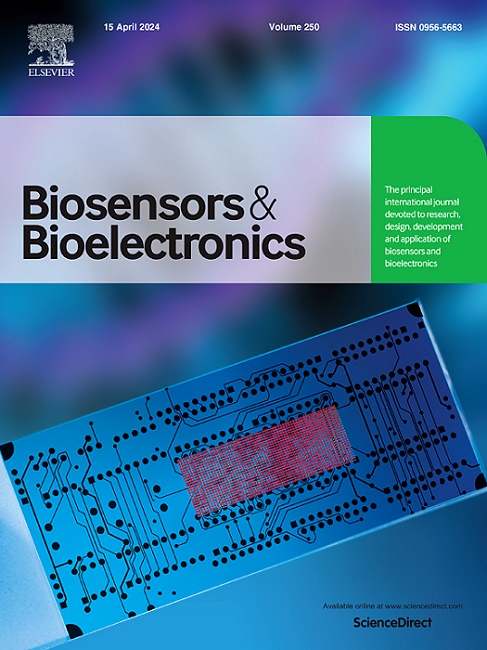层状双氢氧化物纳米片锚定在MXene上的三维互连导电网络结构,用于特别敏感的电化学生物传感平台
IF 10.5
1区 生物学
Q1 BIOPHYSICS
引用次数: 0
摘要
开发精确、灵敏的有机磷农药电化学检测方法对有效调控食品和环境资源中的污染具有重要意义。本研究以壳聚糖(Chit)和乙酰胆碱酯酶(AChE)体系的活性抑制机制为基础,构建了一种新的生物识别平台AChE-Chit/PPy/NiFe LDH/TM/GCE (APLTMG),用于快速检测乐果。具有双金属活性位点的NiFe LDHs被沉积在具有优异导电性的Ti3C2 (TM)衬底上,并与聚吡咯(PPy)三维导电网络集成。这种结构有利于快速电荷转移,并通过协同效应提高性能。在此基础上,APLTMG生物传感器在实际样品中具有较低的检出限(1.459 × 10−11 mol L−1),良好的回收率(97.43% ~ 106.92%)和合理的相对标准偏差(RSD)或变异系数(CV) (< 7.8%)的优异灵敏度。此外,值得注意的是,与LC-MS相比,APLTMG具有相当的重复性,重现性好,存储性能稳定,选择性和检测精度突出。这项工作为基于三维导电结构的高灵敏度生物传感器的开发提供了有价值的见解,在生态资源管理和食品安全监测方面具有潜在的应用前景。本文章由计算机程序翻译,如有差异,请以英文原文为准。
3D interconnected conductive network architectures of layered double hydroxides nanosheets anchored in MXene for particularly sensitive electrochemical biosensing platform
The development of precise and sensitive electrochemical sensing methods for organophosphorus pesticides (OPs) is crucial for effective contamination regulation in food and environmental resources. In this study, a novel biosensing platform, AChE-Chit/PPy/NiFe LDH/TM/GCE (APLTMG), was constructed based on the activity inhibition mechanism of the chitosan (Chit) and acetylcholinesterase (AChE) system as the biorecognition element for the rapid detection of dimethoate. The NiFe LDHs, characterized by bimetallic active sites, are deposited onto the Ti3C2 (TM) substrate with superior conductivity and integrated with a three-dimensional (3D) conductive network of polypyrrole (PPy). This configuration facilitates rapid charge transfer and serves to enhance performance through a synergistic effect. On this basis, the APLTMG biosensor demonstrates exceptional sensitivity with a low detection limit (1.459 × 10−11 mol L−1), good recovery rates (97.43 %–106.92 %), and reasonable relative standard deviation (RSD) or coefficient of variation (CV) (<7.8 %) for dimethoate in real samples. Besides, it is worth noting that the APLTMG exhibits the comparable repeatability, good reproducibility, stable storage performance, prominent selectivity and detection accuracy in comparison with LC-MS. This work provides valuable insights for the development of highly sensitive biosensors based on three-dimensional conductive architectures, with potential applications in ecological resource management and food safety monitoring.
求助全文
通过发布文献求助,成功后即可免费获取论文全文。
去求助
来源期刊

Biosensors and Bioelectronics
工程技术-电化学
CiteScore
20.80
自引率
7.10%
发文量
1006
审稿时长
29 days
期刊介绍:
Biosensors & Bioelectronics, along with its open access companion journal Biosensors & Bioelectronics: X, is the leading international publication in the field of biosensors and bioelectronics. It covers research, design, development, and application of biosensors, which are analytical devices incorporating biological materials with physicochemical transducers. These devices, including sensors, DNA chips, electronic noses, and lab-on-a-chip, produce digital signals proportional to specific analytes. Examples include immunosensors and enzyme-based biosensors, applied in various fields such as medicine, environmental monitoring, and food industry. The journal also focuses on molecular and supramolecular structures for enhancing device performance.
 求助内容:
求助内容: 应助结果提醒方式:
应助结果提醒方式:


